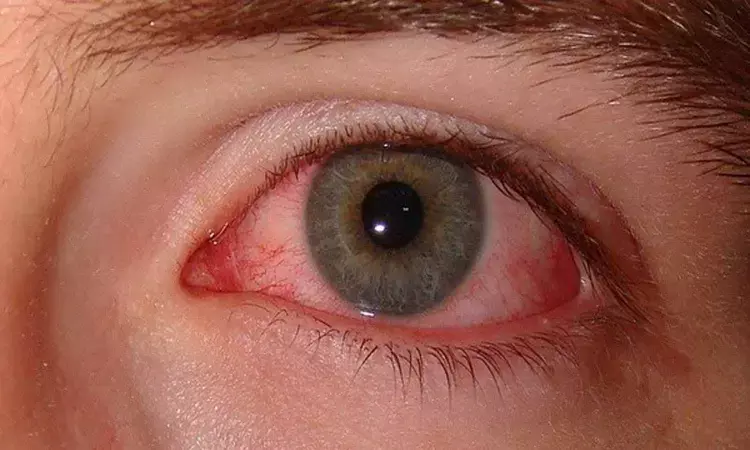- Home
- Medical news & Guidelines
- Anesthesiology
- Cardiology and CTVS
- Critical Care
- Dentistry
- Dermatology
- Diabetes and Endocrinology
- ENT
- Gastroenterology
- Medicine
- Nephrology
- Neurology
- Obstretics-Gynaecology
- Oncology
- Ophthalmology
- Orthopaedics
- Pediatrics-Neonatology
- Psychiatry
- Pulmonology
- Radiology
- Surgery
- Urology
- Laboratory Medicine
- Diet
- Nursing
- Paramedical
- Physiotherapy
- Health news
- Fact Check
- Bone Health Fact Check
- Brain Health Fact Check
- Cancer Related Fact Check
- Child Care Fact Check
- Dental and oral health fact check
- Diabetes and metabolic health fact check
- Diet and Nutrition Fact Check
- Eye and ENT Care Fact Check
- Fitness fact check
- Gut health fact check
- Heart health fact check
- Kidney health fact check
- Medical education fact check
- Men's health fact check
- Respiratory fact check
- Skin and hair care fact check
- Vaccine and Immunization fact check
- Women's health fact check
- AYUSH
- State News
- Andaman and Nicobar Islands
- Andhra Pradesh
- Arunachal Pradesh
- Assam
- Bihar
- Chandigarh
- Chattisgarh
- Dadra and Nagar Haveli
- Daman and Diu
- Delhi
- Goa
- Gujarat
- Haryana
- Himachal Pradesh
- Jammu & Kashmir
- Jharkhand
- Karnataka
- Kerala
- Ladakh
- Lakshadweep
- Madhya Pradesh
- Maharashtra
- Manipur
- Meghalaya
- Mizoram
- Nagaland
- Odisha
- Puducherry
- Punjab
- Rajasthan
- Sikkim
- Tamil Nadu
- Telangana
- Tripura
- Uttar Pradesh
- Uttrakhand
- West Bengal
- Medical Education
- Industry
International coalition classifies 25 subtypes of uveitis

An international coalition of eye researchers used machine learning to develop classification criteria for 25 of the most common types of uveitis, a collection of over 30 diseases characterized by inflammation inside the eye. Together, these diseases are the fifth leading cause of blindness in the United States. The Standardization of Uveitis Nomenclature (SUN) Working Group, funded by the National Eye Institute (NEI), published its classification criteria in the American Journal of Ophthalmology. NEI is part of the National Institutes of Health.
"In the past, clinical research in the field of uveitis has been hampered by the lack of widely-accepted and validated diagnostic criteria," said Douglas A. Jabs, M.D., M.B.A., the SUN project leader and professor of epidemiology and ophthalmology, Johns Hopkins Bloomberg School of Public Health, Baltimore. "These classification criteria are a major step forward for epidemiological studies, translational studies, pathogenesis research, outcomes research, and clinical trials. They hopefully will yield better disease-specific approaches to diagnosis and treatment."
In uveitis, inflammation can be seen in the anterior chamber (anterior uveitis), vitreous (intermediate uveitis), choroid, or retina (posterior uveitis), or all of these (panuveitis). Disease course, complications of uveitis, and the effect on vision vary dependent on the specific disease. Some uveitis appears abruptly and resolves. But many cases are recurrent or chronic, requiring long-term therapy. Symptoms may include floaters, vision loss, pain, and light sensitivity. Uveitis can strike at any age and can have a major impact on quality of life.
Until recently, classification of uveitis was based on the primary location of inflammation. However, types of uveitis affecting the same anatomic location can have different causes, courses, prognoses, and treatment needs. Previous work by the SUN Working Group demonstrated that even uveitis experts can disagree on diagnosis, making apples-to-apples comparisons difficult when conducting clinical research.
"The agreement among uveitis experts on the diagnosis of individual diseases was modest at best. So, we set off to try to provide clarity, using informatics, formal consensus techniques, and technology to assist in classifying each uveitic disease," said Jabs.
The SUN Working Group, a team of nearly 100 international uveitis experts from more than 20 countries and 60 clinical centers, worked together throughout the project, which was conducted in four phases: informatics, case collection, case selection, and machine learning. The researchers used machine learning, a type of artificial intelligence, to help them identify the important characteristics that distinguished each disease.
The informatics phase involved standardizing language to describe each type of uveitis and the mapping of terms to individual diseases. In the case collection phase, the team entered 5,766 cases into a database, averaging 100-250 of each uveitis type. During the case selection phase, committees of nine uveitis experts reviewed the cases and used formal consensus techniques to determine whether they were a specific identifiable disease. Only cases with a more than 75% agreement among experts were included in the final database. The resulting cases (4,046) were put through machine learning using multiple approaches on a subset of the cases ("training set") and the performance of the criteria determined on a second subset of the cases (the "validation set").
The overall performance of the criteria was over 90% within uveitic class, suggesting that the criteria can be used in clinical and translational research. The final step was approval of the proposed criteria by the SUN Working Group.
"The SUN Working Group is excited about this unprecedented effort coming to fruition and the publication of this work, as it should provide the basis for future clinical research in the field of uveitis." concluded Dr. Jabs.
https://www.ajo.com/article/S0002-9394(21)00186-0/fulltext
Hina Zahid Joined Medical Dialogue in 2017 with a passion to work as a Reporter. She coordinates with various national and international journals and association and covers all the stories related to Medical guidelines, Medical Journals, rare medical surgeries as well as all the updates in the medical field. Email: editorial@medicaldialogues.in. Contact no. 011-43720751
Dr Kamal Kant Kohli-MBBS, DTCD- a chest specialist with more than 30 years of practice and a flair for writing clinical articles, Dr Kamal Kant Kohli joined Medical Dialogues as a Chief Editor of Medical News. Besides writing articles, as an editor, he proofreads and verifies all the medical content published on Medical Dialogues including those coming from journals, studies,medical conferences,guidelines etc. Email: drkohli@medicaldialogues.in. Contact no. 011-43720751


